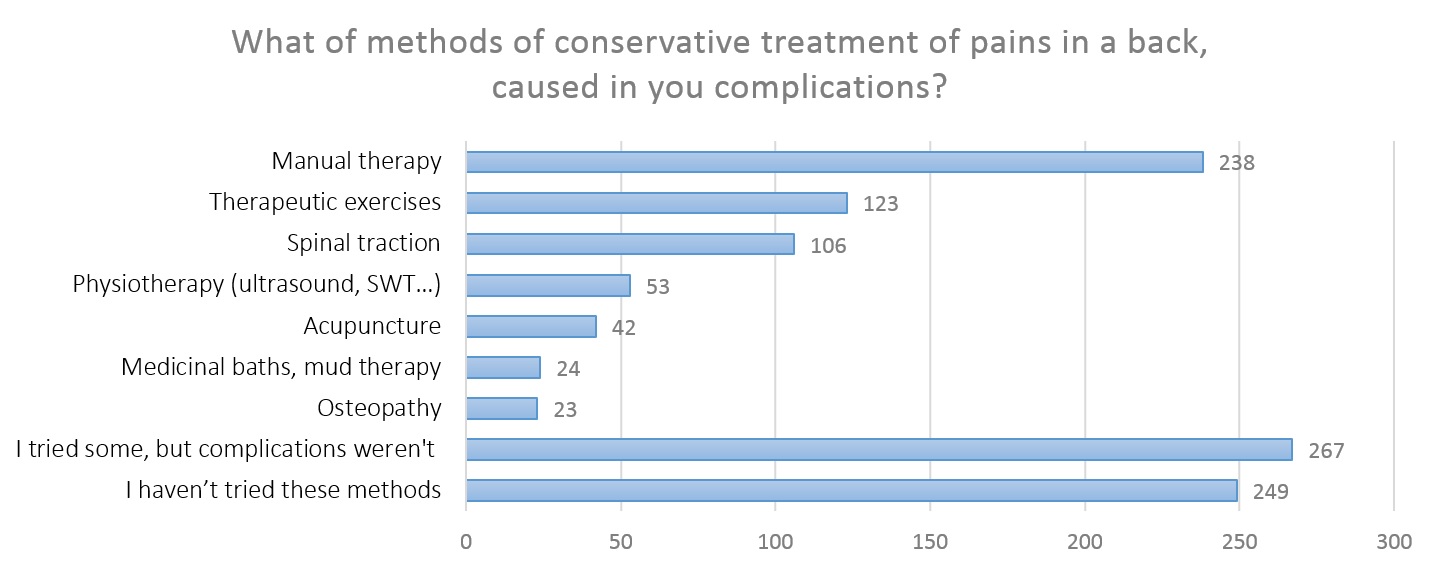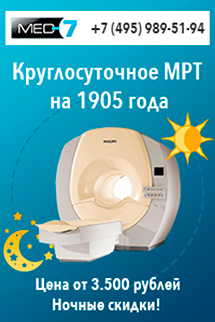Complications of back pain treatment
Treatment of the spine can go quickly and smoothly, but sometimes it causes a new wave of problems as complications develop. New pains in the back and joints, lumbago, inflammation, muscle strain – this all is included into the “standard set” of complicated progression of spinal diseases. We held a poll among the readers of our web site and found out that manual therapy is the absolute leader in the number of complications that develop during conservative treatment of the spine. 21% of those asked complained of complications after manual therapy. 11% and 9% of the complaints are divided between therapeutic exercises and traction respectively. Osteopathic medicine, acupuncture, physiotherapy and mud therapy result in additional complications rarely. So why do such trusted and reliable methods of fighting back pains as traction, therapeutic exercises and manual therapy, become a source of problems?

Whyismanualtherapydangerous
Manual therapy has not become the leader in the number of side effects for nothing. This is so at least because by no means all the doctors who offer to treat your back with this method can boast high professional qualification. The doctor’s mistakes come at a high cost for the patients in such a case. The number of charlatans in the profession of manual therapy is exceeded only by the number of them in unconventional methods of potency treatment. How can one make the right choice of a doctor?
If you seek help of a chiropractor, it’s better to go to government-owned institutions, or at least to large institutes and centers. Do not hesitate to make inquiries about the doctor: how long has he been working, where did he study, and so on. This is an absolutely normal procedure: you are taking a risk, and you want to have guarantees that it’s really a qualified specialist in front of you. Don’t go to those chiropractors who make ample promises. There are no methods of treatment that can give 100% results, and possibilities of manual therapy are limited with a narrow circle of diseases. If the doctor promises to cure you, for example, of multiple sclerosis, it shows that in fact this is a charlatan. Avoid visiting chiropractors “on your own”. Consult your regular doctor, a neurologist or a surgeon, before doing it.
The most common complications of manual therapy include the following problems – in descending order of frequency of occurrences:
- Increased pain. The pain becomes worse after a short break. This happens because the chiropractor applied excessive force to your back that was already sore, the muscles did not relax but were sprained.
- Muscle spasm. It’s the result of the doctor’s overhasty manipulations. The patient was too excited, his muscles were tense; his body was not ready for the procedures. All the techniques of manual therapy must be done only when the patient is completely relaxed.
- Ligament sprain. The cause is the same: application of too much force, doing manipulations then the muscles are tense.
- Blocks, instability, spinal fractures as consequences of frequent unskillful repeating of the manipulations.
- Circulation failures in those cases if you concealed vascular pathologies or diseases from the doctor.
Contraindications to manual therapy
Elderly age with a high degree of senescence. If stair climbing has turned into an ordeal since long ago, and you have already forgotten when you had bent to fasten shoelaces easily for the last time, using manual therapy for treatment is not the best idea.
Acute stage of a disease, acute period of a trauma, period of a chronic disease aggravation. During the acute stage of any disease you must move as little as possible, apply compresses to the sore place and take medications. Manual therapy is not meant for patients who scream with pain. It is used for treatment only during remission stages.
Inflammatory processes in the organism. This can be slightly raised temperature, an inflamed joint or muscle. It is during aggravation periods that inflammations usually show up, but this is not necessarily so. Manual therapy will only exacerbate the problem and contribute to extension of the inflammation in the whole organism quite much.
Abnormal development of the spine, bones, and skull. All the schemes of manual therapy are based on a certain structure of the spine. Any abnormality threatens to bring the doctor’s efforts to nothing and to cause additional sufferings to the patient.
Vascular pathologies, previous skull traumas, systemic diseases, malignant tumors, chronic diseases. You must inform the doctor of all your maladies, even if it seems to you that they irrelevant. Manual therapy is an absolute contraindication with many chronic diseases, it isn’t recommended even to those who suffer from hypertension. If the doctor doesn’t show any interest in your medical record and doesn’t ask any additional questions – this is another reason for doubting his qualification. Ideally it wouldn’t hurt to show the doctor your medical chart that reflects the condition of your health for decades.
Therapeutic exercises: only don’t overdo them!
There is something in common between these three methods: it’s mechanical action on the spine. In two of the cases it is done by the doctor. When a patient does TE, he makes the spine stretch out himself. During this process the distance between the vertebrae changes, the blood flow to the disease site increases, the spinal muscles that hold the vertebrae in a certain position are activated in some or other way. The list of processes we have shown promotes quick recovery, but the same time it is “risky”, making a new flash of pain or muscle rupture possible. How can one avoid complications when doing TE?
- Before going ahead with the manipulations, make sure that you don’t have a single contraindication.
- Elderly age is not a contraindication but a factor that increases the risk of complications. You can start doing therapeutic exercises even at the age of 70, but you have to do it with extreme caution, minimizing the prescribed load. For people older than 67, who can’t boast very good health, it’s risky to use even massage for treatment.
- Never take treatment according to the principle: “more, further, stronger”. Therapeutic exercises aren’t sports. You don’t have to achieve “Olympic sized” results, to exercise till you are blue in the face. It’s quite the contrary. Your task is to listen to your body attentively, and not to do more exercises than you feel able to. Your muscles must not ache in the process, and you must not feel dizzy. Even if the instruction says that you have to do some exercise 10 times – you needn’t follow it blindly.
- Neither manual therapy, not traction, nor TE should be done during an acute stage of the disease, as in this case you will surely have side effects. They are also categorically prohibited if there are any inflammations in the organism, including inflammations of muscles and joints.
The contraindications for TE are the same as for manual therapy, but with some additions. Doing exercises is contraindicated to those who have any circulation failures, heart malfunctions, problems of brain blood vessels, arrythmia.
Ideally you should do TE under a doctor’s supervision. A specialist will help you choose the optimum load, and watch if you do the exercises correctly. The most common cause of complications after TE is the patient's excessive enthusiasm. People find instructions in the Internet and begin doing exercises actively, not performing them quite correctly. You must watch your condition during the process very attentively. The rule is elementary: the exercises must not cause pain. Load must alternate with rest. It’s better to do less than more. Every exercise must be performed smoothly, without jerks.
If you felt a sharp pain while doing therapeutic exercises, this is a signal that you must stop the gymnastics immediately. The pain may be an evidence of muscle or ligament sprain. In theory, one can tear a muscle when doing TE, but this happens rarely. After several workouts most patients develop a dragging or gnawing back pain, it seems their condition has become worse. This is a normal occurrence, the symptoms may aggravate a little before recovery begins. How is this pain different from complications? It doesn’t have a distinct localization, and is more of a gnawing character. Complications are characterized with a sharp or shooting back pain, and indurations or edemas along the spine.
Complications after spinal traction
Spinal traction means that the doctor will apply a long-term or short-term tension to your back. You can imitate the traction method on your own if you hang on a horizontal bar for some time. The spine will stretch a little under the body’s own weight. Each and every method of traction work according to that principle. Traction is commonly used for treatment of traumas and fractures, but as for its effectiveness for degenerative spinal disorders, specialists still argue over it. There are several problems related to this method.
Microruptures and microfissures. Traction promotes occurrence of tiny muscular ruptures and fissures. Fissures are premonitory signs of a future spinal disc herniation. Treatment with this method means a risk of spinal disc herniation development in the future.
Vertebrae return into their previous position with time. Traction is often recommended, for example, for protruded or slipped discs. But experience has shown that discs set by this method will anyway return into their initial “wrong” position with time. And the pain returns too, even becomes stronger sometimes, because joints are traumatized in the process of treatment.
Traction and manual therapy in themselves can’t have a long-term effect, they are only a part of combination treatment. Do you want to set the vertebrae forever or to get rid of droop of shoulders? Select an appropriate course of TE together with a specialist. External mechanical impact promotes decompression of nerves, but it doesn’t strengthen muscles of the back or joints. In addition, there is such a factor as idiosyncrasy to traction. Complications after traction are caused with the following factors:
- The manipulations were done when there were contraindications.
- The manipulations were done when there were no indications for them (osteochondrosis in itself is not an essential indication for traction).
- Wrong choice of the load.
- Noncompliance with the regimen of the manipulation by the patient.
- Noncompliance with the protective regimen after the manipulations are over.
The conclusion is forced upon you: in order to avoid complications you must follow the doctor’s instructions carefully. Otherwise the list of complications that we showed for manual therapy will become of high priority for you.
What to do?
What should those patients do who have already been harmed by manual therapy or other methods of spine therapy? To begin with, do not repeat the bad experience. If manual therapy or TE have induced complications, it means that in the future you’ll have to change your doctor or the set of therapeutic exercises.
In most cases this refers to flashes of pain, muscle spasms or microtraumas. If you have acute pains and sprains, active movements are contraindicated. You need to have a thorough rest, take pain killers, apply a cold compress. And consult your regular doctor as soon as possible (for example, a neurologist, a surgeon or a traumatologist). Maybe you’ll have to have X-ray examination performed, or to submit to other tests – this is up to the specialist to decide. You shouldn’t persist in repeating the manipulations that have induced the complications. It doesn’t mean that manual therapy or therapeutic exercises are a priori contraindicated to you in the future. But you have to change your approach to the treatment: in the first turn, to eliminate the complications themselves.
Avoid excessive physical activity and commotions of the nerves. Try to calm down and to set your mind on recovery. Stress, low mood, and depression are considerable factors that promote the occurrence of complications and side effects.
Понравилась статья? Поделись с друзьями!
Также стоит почитать:
Загрузка...



































 Важно знать:
Важно знать: Полезно:
Полезно: Интересно:
Интересно:




